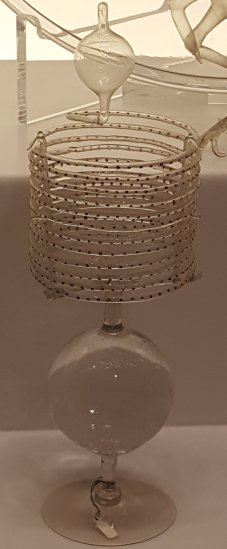
Consider, for example, the glass piece pictured on the far left. It consists of a small vessel, a long, narrow tube rising up from the vessel, and a small bulb at the top of the tube. Believe it or not, that’s a thermometer. Actually, it is more properly called a “thermoscope,” and the first one was designed by Galileo (with the help of some other natural philosophers) in 1593.* Until that time, it was difficult to make any systematic measurement of temperature. People could tell whether it was hot, warm, cool, or cold, of course, but they couldn’t make precise measurements of how hot, warm, cool, or cold it was.
In the late 1500s, Galileo came up with an ingenious solution. He understood that air expanded when it was warmed and contracted when it was cooled. He decided to use that fact to get an accurate measurement of the change in temperature. He designed a device similar to the one above, in which water filled the bottom vessel and ran partway up the thin tube. When the surroundings warmed up, the air above the water (in the tube and in the bulb at the top) expanded, and that pushed the water down the tube. When the surroundings cooled, the air above the water contracted, and that pulled water up the tube.
In other words, the higher the water climbed in the tube, the lower the temperature. By making tiny marks on the side of the tube (shown in the right-hand portion of the picture at the top of this post), he could assign a number to the water’s height. This allowed him to accurately measure changes in temperature. In my elementary science book, Science in the Scientific Revolution, I have students make a very simple version of Galileo’s thermometer with water, a glass, and a plastic bottle.

Despite the fact that I understood exactly how this variation on Galileo’s thermometer would work and why it was superior to the original design, I doubt that I would have ever come up with it on my own. I’m simply not that clever. However, Galileo and the natural philosophers of his day were. The more I learn about people like Galileo, the more I appreciate how intelligent the great thinkers of the past were. Contrary to popular belief, I think it’s possible that they were actually smarter than we are today.
NOTE:
*Please note that a device like this one is often called a “Galileo thermometer,” but Galileo had nothing to do with its design.
Return to Text

It is the height of arrogance that people of modern times assume that they are more intelligent or even “more developed” than people in ancient times. But that is a natural consequence of evolutionary thinking. If someone believes that life and intelligence and civilizations arose through the progress of undirected evolutionary processes, it’s natural for them to believe they are superior to everyone that came before them.
However, having a “smart phone” doesn’t make one smart. I more admire the intellect of Thomas Jefferson with his mastery of multiple languages and his library of books that he had actually read than someone who needs google for a crutch. Information technology can be an intellectual force multiplier. But just like automobiles increase our range of motion but can lead to physical weakness due to lack of exercise, I’m concerned that misuse and over-reliance on information technology can lead to intellectual weakness. Particularly because of entertainment saturation and time wasting. Cat videos …